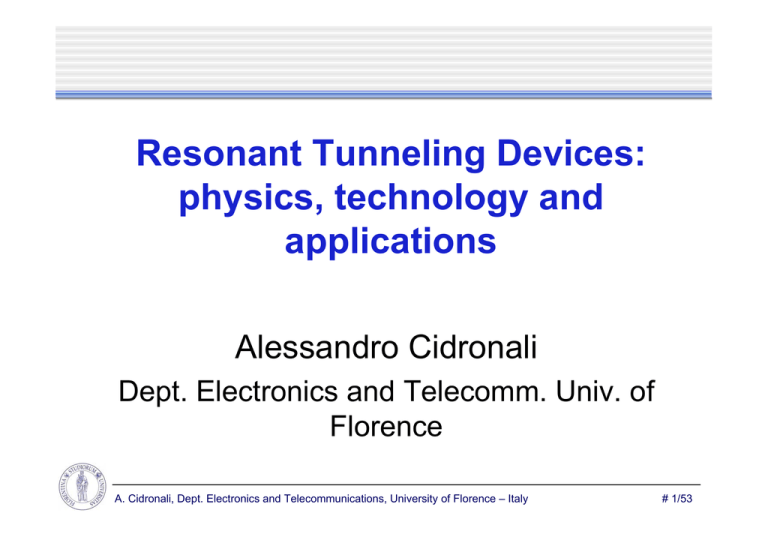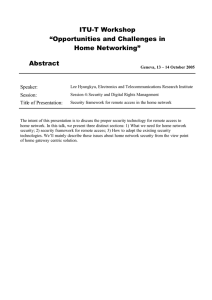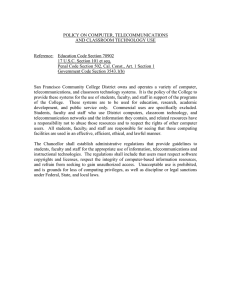Resonant Tunneling Devices: physics, technology and applications
advertisement

Resonant Tunneling Devices: physics, technology and applications Alessandro Cidronali Dept. Electronics and Telecomm. Univ. of Florence A. Cidronali, Dept. Electronics and Telecommunications, University of Florence – Italy # 1/53 Outline • motivations • RTD basics • RTDs physics and models • Applications Exploitation of the NDR Digital applications (gate logic, memory) A. Cidronali, Dept. Electronics and Telecommunications, University of Florence – Italy 6/29/2005 # 2/53 Beyond the MOSFET Moore's laws • • Integration has quadrupled every three year • Minimum dimension has been scale by 0.7 • • Mesoscale : An intermediate scale, on the order of ~10 nm, Materials have some properties of bulk material, but surface effects are important, And more quantum phenomena become important Bulk : Materials & structures fabricated using bulk processes with atomic precision Electronics : Electron states are used for primary information-processing operations not photons (optical), or whole atoms (mechanical) A. Cidronali, Dept. Electronics and Telecommunications, University of Florence – Italy 6/29/2005 # 3/53 What happens @ mesoscale? • MOSFET scaling hampered by quantization of: charge: becomes important @ L ≈ 10 nm in all materials energy levels: important in semiconductors @ L ≈ 10 nm • Can alternative device operating principles exploit these quantization effects rather than be hampered by them? • Some approaches: Single-electron transistors Quantum wells / wires / dots, quantum-dot CAs Resonant tunneling diodes / transistors A. Cidronali, Dept. Electronics and Telecommunications, University of Florence – Italy 6/29/2005 # 4/53 Resonant Tunneling Diodes • Usually based on quantum wells or wires 1-2 effectively “classical” degrees of freedom Source Drain Island (narrow bandgap) Tunnel barriers (wide bandgap) Electron tunnels through barrier Quantized momentum state Electron flow Occupied states in conduction band Unoccupied states Energy A. Cidronali, Dept. Electronics and Telecommunications, University of Florence – Italy 6/29/2005 # 5/53 Resonant Tunneling Transistors • Like RTDs, but an adjacent gate electrode helps adjust the energy levels in the island Gate Source Electron reflection Drain Gate controlled charge induction Occupied states in conduction band A. Cidronali, Dept. Electronics and Telecommunications, University of Florence – Italy 6/29/2005 # 6/53 Why RTDs? • Intrinsic bistability and high-speed switching capability (e.g., 1 ps switch, fmax~1 THz) • Low power consumption • Small device footprint • Increased functionality A. Cidronali, Dept. Electronics and Telecommunications, University of Florence – Italy 6/29/2005 # 7/53 How does an RTD work? Peak current density: IP=ION Peak-to-valley current ratio (PVCR) = ION/IVALLEY A. Cidronali, Dept. Electronics and Telecommunications, University of Florence – Italy 6/29/2005 # 8/53 Valley Current Theory underestimates valley current because of: I IP (i) scattering by phonons and impurities (ii) extra tunneling via impurity states in the barriers (iii) tunneling via X and L states/bands IV (iv) disorder in alloy barriers V (v) interface steps and roughness A. Cidronali, Dept. Electronics and Telecommunications, University of Florence – Italy 6/29/2005 # 9/53 Typical RTD structures A. Cidronali, Dept. Electronics and Telecommunications, University of Florence – Italy 6/29/2005 # 10/53 III-V RTDs • GaAs family AlGaAs/GaAs/AlGaAs • InP family (IP=500 kA/cm2, PVCR=52) InGaAs/AlAs/InAs A. Cidronali, Dept. Electronics and Telecommunications, University of Florence – Italy 6/29/2005 # 11/53 RITDs • p-n type I heterojunction double quantum well RITD PVCR = 144 H. H. Tsai, et al., IEEE EDL, Vol. 15, no. 9, Sep. 1994 A. Cidronali, Dept. Electronics and Telecommunications, University of Florence – Italy 6/29/2005 # 12/53 RTDs in other materials systems: Molecular RTDs • Small (~1.5 nm): ultra-dense IC based on polyphenylene • Natural nanometer-scale structure: identical in vast quantities methylene James C. Ellenbogen, “A brief overview of nanoelectronic devices” A. Cidronali, Dept. Electronics and Telecommunications, University of Florence – Italy 6/29/2005 # 13/53 A. Cidronali, Dept. Electronics and Telecommunications, University of Florence – Italy 6/29/2005 # 14/53 Conventional Methods of Device Modeling • • • • Electrons are waves. de Broglie wavelength of an electron is: h/p, where p is the momentum Device dimensions are much larger than the electron wave length Transit time through the device is much larger than the scattering time Diffusion equation for semiconductors Diffusive Ballistic Phase-coherent A. Cidronali, Dept. Electronics and Telecommunications, University of Florence – Italy 6/29/2005 # 15/53 Transport processes in RTD A. Cidronali, Dept. Electronics and Telecommunications, University of Florence – Italy 6/29/2005 # 16/53 Quantum device modeling A. Cidronali, Dept. Electronics and Telecommunications, University of Florence – Italy 6/29/2005 # 17/53 coherent approach: Scroedinger eq. Boundary conditions ! The system is open since there is a current flux. Usual boundary conditions, like infinite barrier or periodic repetition of the system, cannot be used. A. Cidronali, Dept. Electronics and Telecommunications, University of Florence – Italy 6/29/2005 # 18/53 Transfer Matrix: envelope function A. Cidronali, Dept. Electronics and Telecommunications, University of Florence – Italy 6/29/2005 # 19/53 Tunneling current A. Cidronali, Dept. Electronics and Telecommunications, University of Florence – Italy 6/29/2005 # 20/53 Self-consistent calculations A. Cidronali, Dept. Electronics and Telecommunications, University of Florence – Italy 6/29/2005 # 21/53 Wigner function i= ∂ ψ ( x, t ) = Hˆ ψ ∂t ρ ( r, s, t ) = ψ ( r, t ) ⋅ ψ ( s, t ) 1.Change of basis Density matrix 2.Fourier transform +∞ n (r ) = ∫ f W (r , k )dk −∞ +∞ J (r ) = −q ∫ k ⋅ f W (r , k )dk −∞ A. Cidronali, Dept. Electronics and Telecommunications, University of Florence – Italy 6/29/2005 # 22/53 Wigner function: results Simulated GaAs RTD structure: equilibrium selfconsistent conduction band, Fermi levels, and doping. The 0.3 eV Al0.3 Ga0.7 As tunnel barriers are 3 nm thick, and the GaAs quantum well width is 5 nm. The center 17 nm of the device (including 3 nm outside each tunnel barrier) are undoped. Self-consistent, steady-state RTD I-V curve showing negative differential resistance, hysteresis, and bistability. The RTD is unstable (oscillates perpetually) in the plateau between 0.239 V and 0.254 V, and it is marginally stable (oscillates with slow damping) in the remainder of the plateau. Biegel and Plummer IEEE TED-44, 733 (1997) A. Cidronali, Dept. Electronics and Telecommunications, University of Florence – Italy 6/29/2005 # 23/53 Wigner function: results A. Cidronali, Dept. Electronics and Telecommunications, University of Florence – Italy 6/29/2005 # 24/53 Applications • • Analog circuits ------ NDR & I\V square law Digital Logic ------ Bistability A. Cidronali, Dept. Electronics and Telecommunications, University of Florence – Italy 6/29/2005 # 25/53 the HITFET structure for uW Applications: QMMIC HITD grown by MBE on top of HEMT layers improved Esaki diode (+1 well\1barrier): higher Jp/Jv and Fmax better reliability because InP substrate, PVCR~50, Fmax~60GHz drain p++ source gate n++ Ohmic InAlAs Schottky InAlAs Spacer InGaAs channel InAlAs buffer InP substrate p+ - InGaAs Top contact layer (anode) nid - InAlAs Barrier nid - InGaAs Well n++ - InAlAs Ohmic contact n+ InGaAs Bottom contact layer (catode) nid - InAlAs Schottky contact (gate) n- InGaAs Si δ-doping nid - InAlAs Spacer nid - InGaAs Channel nid - InAlAs Buffer InP Substrate A. Cidronali, Dept. Electronics and Telecommunications, University of Florence – Italy H I T D H F E T 6/29/2005 # 26/53 The drain-HITFET reflection coefficients at 6.2GHz, Vdrain=500mV as seen from the: 8 CD-HITFET 7 6 dB(Γ) bias 5 4 3 Γ 2 -0.5 -0.4 -0.3 -0.2 -0.1 0.0 0.1 0.2 0.3 0.4 0.5 Vgs Γ -50 bias phase(Γ) CS-HITFET -60 -70 -80 -0.5 -0.4 -0.3 -0.2 -0.1 0.0 0.1 0.2 0.3 0.4 0.5 Vgs A. Cidronali, Dept. Electronics and Telecommunications, University of Florence – Italy 6/29/2005 # 27/53 HITFET based VCO topologies\prototypes Common-Drain (CD) VCO Common-Source (CS) VCO V_DC Lr V_DC Cr HITD HITFET RF-Port HEMT HITD Ca Rc HITFET HEMT Lr Cr Rc RF-Port V_T V_T prototypes, all working at the bias voltage Vdc=0.5V : ‘A’ : CD-VCO @ 6.1GHz ‘B’ : CS-VCO @ 6.3GHz A. Cidronali, Dept. Electronics and Telecommunications, University of Florence – Italy 6/29/2005 # 28/53 6.3 -14 6.25 -17 6.2 -20 6.15 -23 6.1 -26 6.05 -29 6 -0.5 -0.4 -0.3 -0.2 -0.1 0 0.1 0.2 0.3 0.4 0.5 Power Output [dBm] Oscillation Frequency [GHz] HITFET based VCO prototype ‘A’ -32 Tuning Voltage [V] output frequency 6.18 GHz output power -16dBm tuning range 140 MHz SSCR -105dBc/Hz @ 5MHz efficiency 3% power supply 850µW supply voltage 500mV die size 450x550µm2 A. Cidronali, Dept. Electronics and Telecommunications, University of Florence – Italy 6/29/2005 # 29/53 HITFET based VCO prototype ‘B’ -14 -17 6.378 -20 6.376 -23 6.374 -26 6.372 6.37 -29 -0.5 -0.4 -0.3 -0.2 -0.1 0 0.1 0.2 0.3 0.4 0.5 Power Output [dBm] Oscillation Frequency [GHz] 6.38 to S.A. Rc=1KΩ Lext V_dd=0.5mV V_T -32 Tuning Voltage [V] output frequency 6.37 GHz output power -17dBm tuning range 3 MHz SSCR -97dBc/Hz @ 230KHz efficiency 3% power supply 850µW supply voltage 500mV die size 450x550µm2 A. Cidronali, Dept. Electronics and Telecommunications, University of Florence – Italy 6/29/2005 # 30/53 figure of merit (4-6.5GHz) ⎛f FOM = ⎜⎜ 0 ⎝ fn 175 [11] 170 [13] [12] 165 [this work: prot.’B’ ] Figure of Merit, dB [this work: prot.’C’ ] 160 [10] 150 [5] 145 [6] [8] [7] [2] 140 [1] [4] 135 2. Kinget, 0.35um CMOS, proc. ISSC 1998 3. Shealy, GaN FET, IEEE MWCL 2001 4. Yu, InP HBT, IEEE MWCL 2001 5. Mostafa, 0.35um CMOS sub-1V, IEEE T-CS-II 2001 6. Mostafa, 0.35um CMOS, proc. IEEE CS 2001 7. Loo, BJT differential, 2000 Canadian Conf. 8. Liu, 0.35um CMOS, proc. ISSC 1998 9. Vaananen, 0.35um BiCMOS, IEEE JSSC 2001 11. Ellinger, classE GaAs VCO, IEEE T-MTT 2001 [3] 12. Deval, Synchronous CMOS VCO, IEEE RFIC Sym. 2001 125 4 Arhens, MOS w/ resonator, proc. ISSC 1996 10. Van de Ven, LC MOS, 2001 Sym. VLSI Si - devices III-V - devices 130 1. [this work: prot.’A’ ] [9] 155 ⎞⎟2 1 ⎟⎟ ⎠ PDC ⋅ SSCR ( fn ) 4.5 5 5.5 freq, GHz 6 6.5 13. Klepser, SiGe BiCMOS, IEEE RFIC Sym. 2001 HITFET-VCOs HITFET-VCOsshow showthe thelowest lowestpower powersupply supply A. Cidronali, Dept. Electronics and Telecommunications, University of Florence – Italy 6/29/2005 # 31/53 the QMMIC limitation • Not all the active functions can be replaced; e.g. difficult to replace LNA, PA, Switch • On a one-to-one basis, the individual functions in QMMIC could be more effective than conventional ones (e.g. VCOs and mixers) • In the overall budget, however, the benefit might be marginal A. Cidronali, Dept. Electronics and Telecommunications, University of Florence – Italy 6/29/2005 # 32/53 the QMMIC as enabling technology How to improve the effectiveness taking advantage of the unique features of QMMIC technology? By introducing appropriate architectures whose application is enabled by the features of QMMIC technology - enabling technology approach the Quantum Bi-Directional Amplifer (QBDA) for Tagging Applications A. Cidronali, Dept. Electronics and Telecommunications, University of Florence – Italy 6/29/2005 # 33/53 Bi-directional amplifier based on HITD The basic idea: The reflection coefficient (Γ) of a device exhibiting a NDR is >1 Combining by a 90° directional coupler two HITDs, the output signal is Γ times the input one The scattering matrix is of the form: Γa*0.5+Γ(j*j)a*0.5=0 a/ 2 input:a NDR device Γ(a / 2) ouput: ja / 2 Γja*0.5+Γja*0.5 Γ(ja/ 2) S = Sr St St Sr NDR device A. Cidronali, Dept. Electronics and Telecommunications, University of Florence – Italy 6/29/2005 # 34/53 QBDA prototype 10 5 dB(S(1,2)) dB(S(2,1)) dB(S12), dB (S21) A Quantum MMIC bi-directional amplifier has been demostrated @ 5.8GHz; main characteristics: 450mV\0.5mA power supply, gain 4.7dB. More work to control the HITD parameters is required. 0 -5 -10 -15 3.0 3.5 4.0 4.5 5.0 5.5 6.0 6.5 7.0 7.5 8.0 8.5 9.0 dB(S11), dB (S22) freq, GHz A. Cidronali, Dept. Electronics and Telecommunications, University of Florence – Italy 6/29/2005 # 35/53 An application of the QBDA: the PM reflective TAG Terminating a port of the QBDA by a two-state load (e.g. a HITD properly biased) a reflection equal to 2 times the QBDA gain is obtained with a phase swing of 180° QBDA A. Cidronali, Dept. Electronics and Telecommunications, University of Florence – Italy 6/29/2005 # 36/53 An application of the QBDA: the PM reflective TAG 0.02 150 ref, V 10*inc 0.01 100 0.00 50 -0.01 d3, mV 0 -0.02 -50 8 10 12 14 time, nsec 430 200 420 d3, mV 150 d2, mV d1, mV Terminating a port of the QBDA by a twostate load (e.g. a HITD properly biased) a reflection equal to 2 times the QBDA gain is obtained with a phase swing of 180° 200 100 50 410 400 390 380 0 370 -50 0 20 40 60 80 100 8 9 10 time, nsec A. Cidronali, Dept. Electronics and Telecommunications, University of Florence – Italy 11 12 13 14 15 time, nsec 6/29/2005 # 37/53 QMMIC Summary Highlights: – TDs may be considered as an optimizing technology for extremely low power (<500mV) RF electronics, (e.g. VCO). – new circuit functionalities are enabled by Tunnel Devices. – at system and circuit levels, TDs introduce new degree of freedom, (e.g. BDA). Next steps: – Tight control of series resistance and parasitics. – Device engineering at quantum mechanic level. – Application to millimeter-wave transceiver A. Cidronali, Dept. Electronics and Telecommunications, University of Florence – Italy 6/29/2005 # 38/53 Applications — Digital Logic • Logic circuits ------ Bistability • Integration with transistors (HEMT, HBT, CMOS) is a requirement for a complete IC technology based on RTDs Transitors: Input/output isolation, controllable gain RTDs: increased functionality, enhanced circuit speed, reduced power consumption • It’s all about Load lines! A. Cidronali, Dept. Electronics and Telecommunications, University of Florence – Italy 6/29/2005 # 39/53 Inverter I VDD I VIN=LO VOUT=HI VIN VOUT VIN=HI VOUT=LO • • VOUT Concept: A digital inverter cell with a low on-state current for low static power dissipation Evaluation: The low on-state current also reduces the switching speed because the current stays low until the RTD again reaches resonance A. Cidronali, Dept. Electronics and Telecommunications, University of Florence – Italy 6/29/2005 # 40/53 Monostable-bistable transition two stable states RTD latch: Iin RTD load RTD drive • • • Voltage biasing two RTD’s in series results in a bistable circuit. The state of a bistable pair is given by the voltage of the DATA NODE (OUT). the stable equilibrium states are labeled as “0” STATE and “1” STATE. A. Cidronali, Dept. Electronics and Telecommunications, University of Florence – Italy 6/29/2005 # 41/53 Non-equilibrium RTD-latch switching ‘0’ state time ‘1’ state • To establish a new state in a latch, it must first be brought to a monostable bias and returned quickly to the bistable level. • To set a latch to ‘1’, an input current, Iin, must be supplied to the data node during the restoration of the bias voltage to the bistable level; otherwise: ‘0’ the latch will be reset to the low-voltage state. • When the total drive current is less than the drive-RTD conduction current, the capacitive current is negative and the voltage is driven lower. • Likewise, when the total drive current is above the drive RTD conduction current, the voltage is driven higher. A. Cidronali, Dept. Electronics and Telecommunications, University of Florence – Italy 6/29/2005 # 42/53 RTD logic gates delay OR XOR (NOT: one input kept 1) AND A. Cidronali, Dept. Electronics and Telecommunications, University of Florence – Italy 6/29/2005 # 43/53 Monostable BIstable Logic Element (MOBILE) • To establish a new state in a latch, it must first be brought to a monostable bias and returned quickly to the bistable level. • To set a latch to ‘1’, the HFET is OFF: if Al>Ad, a net current charge the RTD driver capacitance, resulting in a switch toward the high voltage • otherwise: the HFET is ON the net current in the DATA NODE is such that the capacitive current is negative and the voltage is driven lower. A. Cidronali, Dept. Electronics and Telecommunications, University of Florence – Italy 6/29/2005 # 44/53 MOBILE Flip-Flop Circuit Operating at up to 35 Gb/s A. Cidronali, Dept. Electronics and Telecommunications, University of Florence – Italy 6/29/2005 # 45/53 Multivalued Logic • Operating Principle of Ternary Quantizer Ip(A)> Ip(B)> Ip(X)> Ip(Y) A. Cidronali, Dept. Electronics and Telecommunications, University of Florence – Italy 6/29/2005 # 46/53 Multivalued Logic A. Cidronali, Dept. Electronics and Telecommunications, University of Florence – Italy 6/29/2005 # 47/53 RTD-CMOS • Substantial improvement in speed, power dissipation, and circuit complexity over CMOS only circuits. • A hybrid integration process for RTD to be transferred and bonded to CMOS J. I. Bergman, et al., IEEE EDL, Vol. 20, no. 3, March 1999 A. Cidronali, Dept. Electronics and Telecommunications, University of Florence – Italy 6/29/2005 # 48/53 RTD-CMOS A 1-bit conventional CMOS comparator: 18 devices A 1-bit RTD/CMOS comparator: 6 devices J. I. Bergman, et al., EDL, 1999 A. Cidronali, Dept. Electronics and Telecommunications, University of Florence – Italy 6/29/2005 # 49/53 Memory cell VRTD Write Select IRTD Read Select RTD1 RTD2 RTD1 Read Data Write Data Storage Node RTD2 IRTD VLO VHI VRTD Storage Node • Concept: A static memory cell with a low device count and low static power dissipation A. Cidronali, Dept. Electronics and Telecommunications, University of Florence – Italy 6/29/2005 # 50/53 T-SRAM TSRAM cell test circuit. Vref is 1.0 V and RTD bias Vref+ is 0.45 V (2-state) or 1.0 V (3-state). The source follower at the storage node, SN, provides the read output Vout. A. Cidronali, Dept. Electronics and Telecommunications, University of Florence – Italy 6/29/2005 # 51/53 T-SRAM Fabricated 4x4 1T-cell TSRAM array. Write–read cycles for high and low inputs for the 4x4-bit TSRAM chip. Horizontal grid scale is 50 ns/div, vertical grid scale is 100 mV/div. The letters “W,” “S,” and “R” stand for write, store, and read, respectively. A. Cidronali, Dept. Electronics and Telecommunications, University of Florence – Italy 6/29/2005 # 52/53 Promising Future A. Cidronali, Dept. Electronics and Telecommunications, University of Florence – Italy 6/29/2005 # 53/53


